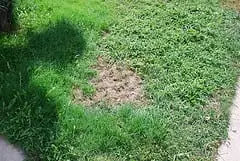As much as we adore our canine companions, the challenges of dog ownership can manifest in various unexpected ways—one of which is the notorious brown spots that mar lawns everywhere. These unsightly patches, often linked to the nitrogen content in dog urine, can lead to significant frustration for pet owners who love their furry friends but also wish to maintain a beautiful yard. While dog urine isn’t the sole culprit of lawn damage, understanding its effects and implementing preventative measures can go a long way in preserving both your pet’s and your lawn’s health.
The primary reason for lawn discoloration due to dog urine is nitrogen. Dr. Denise Petryk, a veterinarian, explains that the nitrogen levels are exacerbated by the protein-rich diets that many dogs consume. High protein intake translates into higher nitrogen concentrations in their urine, resulting in the infamous burn marks on the lawn. However, it’s crucial to emphasize that simply switching to a low-protein dog food as a remedy for burnt grass is not advisable. Doing so compromises your dog’s health and nutrition. Instead, proactive measures focused on the lawn and its care are far more effective.
A common pitfall for many dog owners is turning to fertilizers in a desperate attempt to revive their burned patches of grass. This is a misguided approach; most fertilizers contain high nitrogen levels, which can further exacerbate the problem rather than alleviate it. Understanding that brown spots should not be treated as a symptom needing quick fixes will help pet owners approach lawn care more effectively. As Dr. Petryk clarifies, enhancing the lawn through careful attention to soil pH, appropriate watering schedules, and aeration can yield better results.
Preventing brown spots is a much more effective strategy than trying to fix them after they appear. Dr. Petryk recommends several practical tips to protect your lawn from the damaging effects of dog urine. One approach is to control where your dog urinates by using a leash, thus designating an area away from your prized grass. Additionally, watering the impacted area immediately after urination can dilute the nitrogen concentration and reduce damage.
Encouraging your dog to drink more water is another beneficial strategy to consider. Increased hydration dilutes urine, making it less likely to cause harm to your lawn. There are several ways to encourage your dog’s water intake, which include offering ice cubes, diluted juices, or even mixing water into food. However, it’s essential to monitor your pet closely; increased fluid intake naturally means more frequent trips outside.
Creating a specific potty area can also provide a lasting solution for lawn upkeep. Bryan Kratz from NaturalLawn of America suggests training your dog to urinate in a designated spot, such as a gravel patch or mulch area. Not only does this prevent lawn damage, but it can also create a more aesthetically pleasing yard. Additionally, this practice can simplify clean-up, allowing you to maintain control over your pet’s toileting habits.
When researching solutions to mitigate brown spots on lawns, you may encounter various products marketed for this very purpose. However, it is crucial to be cautious with these products as they can sometimes harm pets. The bioavailability of chemicals through paw exposure raises significant health concerns. One notable natural option worth discussing is Dog Rocks, a product derived from Australian minerals that claim to filter out harmful nitrates from a dog’s drinking water. Users of Dog Rocks report success in preventing lawn burn due to its ability to neutralize harmful components; still, it does not address pre-existing damage.
Ultimately, controlling and preventing lawn damage from dog urine requires a combination of understanding, education, and adaptive strategies. While there may be some limitations to regrowing grass once it has been damaged, the proactive measures mentioned can help to mitigate the initial effects of dog urine on your lawn. Keeping a healthy lawn alongside a healthy pet is about finding the right balance—embrace the joys of dog ownership while respecting the natural landscape around you. Remember, the health of your dog should always take precedence over the aesthetics of your yard. With adequate care and commitment, both can thrive together.

